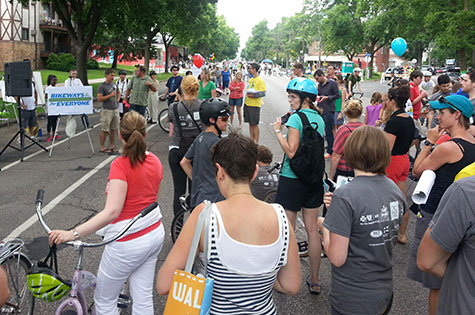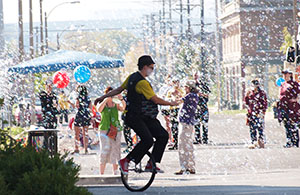
Open Streets Initiatives — the opening of streets normally reserved for vehicle traffic to temporarily allow cycling, walking, dancing and socializing — are growing in the United States. Now, thanks to researchers at the Brown School at Washington University in St. Louis, a toolkit is in place to help communities and organizers measure their positive impact.
“More than 100 cities in the United States have hosted an Open Streets event in the last five years,” said J. Aaron Hipp, PhD, assistant professor of public health at the Brown School, “but very few evaluate, and what they do evaluate has been inconsistent.”
Open Streets movements, also known as Ciclovias, originated in South America as a way to get people to socialize, exercise and simply see life in their city from a different perspective. In some communities in the Southern Hemisphere, events are held weekly and attract millions of visitors. Where Open Streets are part of the culture, Hipp said, they are a vital part of a community’s public health outlook.

“The Centers for Disease Control currently defines 150 minutes per week of physical activity as optimum for adult health,” Hipp said. “So if you can attend an Open Street event say, every Saturday or Sunday, and for
2 1/2 hours walk, jog, ride your bike, dance, or participate in associated activities, that one event could have tremendous impact.”
Hipp and researchers at the Brown School, with the support of Active Living Research, have been evaluating events in the St. Louis area over the past four years. They have developed a 46-page toolkit that is available online, with templates, that measures the success of different aspects of an Open Streets initiative or event. Such measures of success may include the number participating, the amount of physical activity occurring, the number who learn about a new bike lane, or money spent at surrounding businesses and restaurants.
“It really depends on what your city is interested in,” Hipp said. “Are you interested in the local business and economic aspect? Do you just want to know who is there and how many? Are you interested in knowing if people are meeting the 150 minutes of physical activity? The social aspects? Are you getting different areas of the city involved?
“Cities and hosts of Open Streets are eager to measure success and evaluate their initiative,” he said. “They see a successful initiative and they want to replicate it. To sell the idea to businesses, to city councils, to mayors, to make the initiatives sustainable, you’ve got to have some type of data and measure of success.
The toolkit is available through the Prevention Research Center (PRC), a joint initiative of the Brown School and researchers at Saint Louis University. Active Living Research also has the kit and templates and the Alliance for Walking and Biking website features it as well.
In the meantime, Hipp and his PRC colleagues continue to evaluate and research Open Streets. The article “Taking Physical Activity to the Streets: The Popularity of Ciclovia and Open Streets Initiatives in the United States” was published in the January/February 2014 issue of American Journal of Health Promotion.

Written by Hipp along with Amy A. Eyler, PhD, assistant professor of public health at the Brown School; Susan G. Zieff, PhD, professor at San Francisco State University; and Michael A. Samuelson of the Alliance for Biking & Walking, with funding from the Robert Wood Johnson Foundation, the article studies the growth of Open Streets movements from 2008-13.
Another article, “Open Streets Initiatives in the U.S.: Closed to Traffic, Open to Physical Activity” by Jill A. Kuhlberg, doctoral student at the Brown School; Hipp; Eyler and Genevieve Cheng, former research assistant at the Brown School, is forthcoming in the Journal of Physical Activity & Health.
In addition, Hipp and Lin Yang, PhD, with the help of a grant from the Institute for Public Health’s Harvey A. Friedman Center for Aging, will be traveling to Santiago, Chile, this year to study Ciclovias there as well as meeting with representatives from Bogota, Colombia, who started the movement.
“It’s engaging work,” Hipp said. “Most of us use these streets every day, whether in a personal vehicle or via public transportation. But Open Streets help people see the city at a different speed and from a different perspective.
“Communities and neighbors are getting their physical activity, but they are also meeting one another and discovering new retail in and around their neighborhoods,” Hipp said.